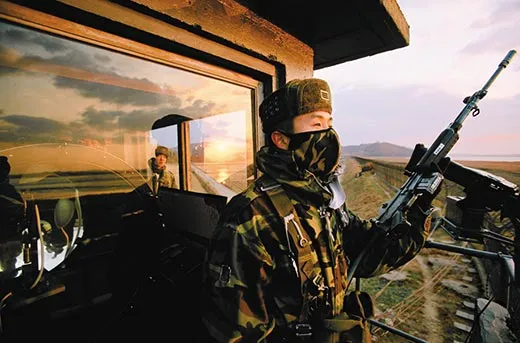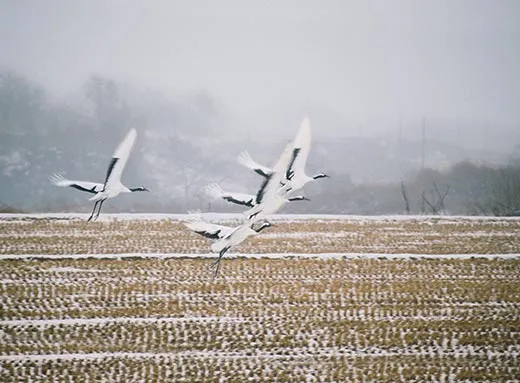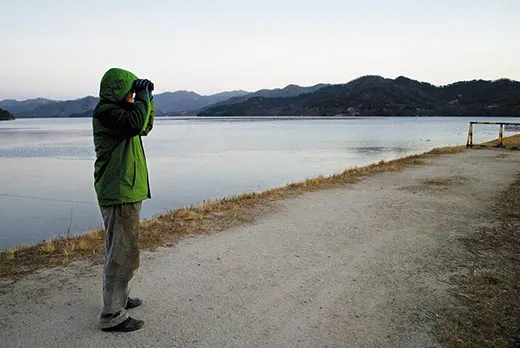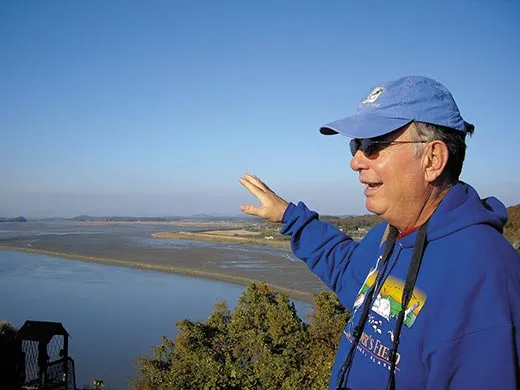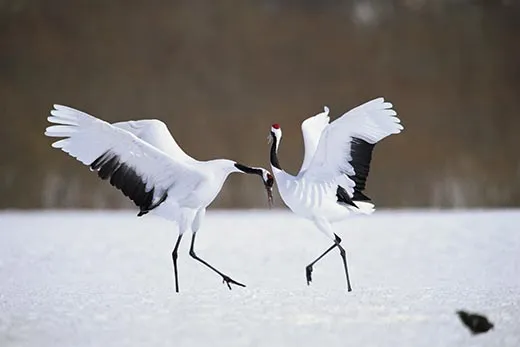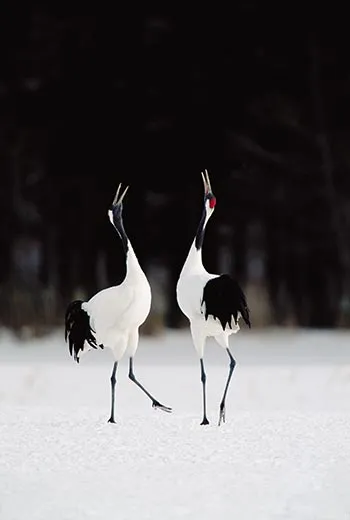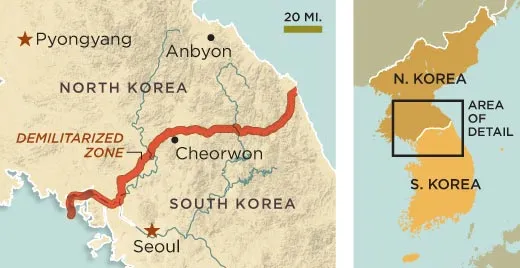The DMZ’s Thriving Resident: The Crane
Rare cranes have flourished in the world’s unlikeliest sanctuary, the heavily mined demilitarized zone between North and South Korea
/https://tf-cmsv2-smithsonianmag-media.s3.amazonaws.com/filer/Cranes-red-crowned-cranes-flying-631.jpg)
Choi Jong Soo and I are driving down a two-lane highway surrounded by rice fields, acres and acres of them, lying fallow for the winter. A few miles in the distance are mountains that seem too steep and jagged for their modest heights. We pass checkpoints, roadblocks. Heavily armed soldiers eye us from small huts. Every so often, helicopters sweep overhead. We are in the Cheorwon Basin, a little more than two hours northeast of Seoul, South Korea, and less than one mile from the Demilitarized Zone, or DMZ, the 2.5-mile-wide no man’s land that separates North and South Korea. Choi, my guide, nods at the mountains. “North Korea,” he says. “Very close.”
A couple of weeks before I arrived, North Korean forces had shelled Yeonpyeong Island, off the west coast of the Korean peninsula. Two South Korean marines and two civilians were killed—the first civilian deaths in decades. The Korean War began in 1950 when the United Nations and the United States helped the South repel an invasion from the North. At least three million died, including 58,220 Americans. The 1953 armistice brought an uneasy end to hostilities, but the two countries never signed a peace treaty and are still technically at war. Many South Koreans with whom I’ve spoken seem to have taken the latest developments in stride. For them, North Korea is like a fault, or a volcano, or some other intermittent, potentially cataclysmic phenomenon over which they have no control. I, however, am a little on edge.
Choi and I turn onto a dirt road and are soon navigating the maze of narrow, rutted dikes that demarcate the fields. The SUV bucks and heaves; flocks of mallards and white-fronted geese flurry into the air. Suddenly, Choi points out my window and exclaims, “Turumi!” I look but see nothing. He gestures more emphatically, so I take another look. Straining, and then pulling out my binoculars, I see two—no, three—white dots about half a mile away. They are red-crowned cranes, two adults and a chick, foraging among ordered bristles of rice stalks. I glance back at Choi and shake my head. How did he see them so far away? He grins. “Soldier’s eyes,” he says.
Twenty years ago he was a captain in the South Korean Army, stationed in a fishing port near the border. He was on watch one morning, he says through an interpreter, when he saw an enormous white bird fly overhead. He thought it was the most beautiful thing he had ever seen. It was a red-crowned crane, and he resolved to learn everything he could about it. Today he works for the Korean Society to Protect Birds.
Choi does regular surveys of the two crane species—the red-crowned and the white-naped—that winter here in the Cheorwon Basin. Every morning at 5:00, he drives out to these fields to count all the crane families he can find and spread out grain for them. Each family consists of two adults—they may mate for life and can live more than 25 years—and one or two chicks, which stay with their parents for about three months.
The rest of the year, Choi works with local farmers, teaching them about the birds and how to protect them. Sometimes he helps the farmers harvest crops. In exchange, he asks them to leave their fields unplowed so that cranes will have more waste rice to forage on come winter.
Whenever we approach a flock of cranes, Choi says, “Gwen-cha-no, gwen-cha-no.” You’re OK, you’re OK. If the cranes leap away in flight, he calls, “Mi-an-he, mi-an-he!” Sorry, sorry! Once, we saw 15 cranes feeding. We rolled slowly toward them. They leaned into the wind, their necks stiff, prepared to flee. We stopped, and Choi hunched down behind the steering wheel. The cranes relaxed. Choi exhaled slowly. Then two helicopters burst out from behind a hillside, and the cranes vaulted away.
The red-crowned crane is one of the rarest birds in the world; fewer than 3,000 survive in the wild. (The whooping crane, in North America, is even more rare, with 382 in the wild.) It has two main populations. One lives year-round on the northern Japanese island of Hokkaido. Thousands of people visit special feeding stations each winter—high courtship season—to watch the birds call and leap and dance in the snow.
The other population breeds in the wetlands of the Amur and Ussuri rivers in southeast Russia and northern China. These birds migrate to coastal areas in China’s Jiangsu Province or to the Korean peninsula. Scientists assume this population fared poorly during World War II and the Korean War, given that cranes favor large, open, quiet spaces.
But since the 1953 cease-fire, the DMZ has become something of an unintended nature reserve. The 154-mile-long borderland, once densely populated and farmed, was abandoned. Trees and grasslands replaced towns and crops. Not that the land is entirely unmolested. On one edge is the one-million-strong North Korean Army; on the other are 600,000 South Korean and 17,000 U.S. soldiers. Between them are tank traps, infiltration tunnels and as many as a million land mines. But species that were otherwise eliminated from the rest of the peninsula—the Asiatic black bear, for instance, or the Siberian musk deer—still lurk in the midst of all that poised firepower.
In 1961, an American serviceman reported that more than 2,000 white-naped cranes rested in the DMZ before flying on. More reports followed. White-naped and red-crowned cranes were roosting in the Han-Imjin estuary that drains into the Yellow Sea near Seoul and in the Panmunjom Valley in the DMZ. In the early 1970s, both crane species were discovered again, in the Cheorwon Basin, part of which is inside the DMZ and much of which is in the Civilian Control Zone, or CCZ, a buffer just south of the DMZ that runs parallel to it. Farming is allowed in the CCZ, but public access is restricted. Currently, about 800 red-crowned cranes and 1,500 white-naped cranes winter in or near the basin.
“It really is quite astounding to think of cranes surviving in such a place, but they seem to prefer contested territories,” says George Archibald, co-founder of the International Crane Foundation in Baraboo, Wisconsin.
Archibald is a world authority on cranes as well as their most spirited champion. He has worked for nearly 40 years to protect them. He began captive breeding cranes in 1972, had human handlers dress as cranes to feed chicks, and even danced with adult cranes to encourage them to mate. To see the world’s 15 different species in their native habitats, he has traveled to all manner of hostile terrains. He first visited the cranes in the DMZ in 1974.
Archibald argues that the DMZ should be turned into an ecological reserve, a proposal that would require an unprecedented embrace of conservation in South Korea, a country better known for encouraging development. But having such a refuge is critical for the bird’s future. “In other parts of South Korea, most crane habitat is very degraded,” Archibald says. “If and when North and South Korea reunite, the development pressures on the DMZ are going to be severe.” In the event of reunification, a huge port is proposed for the DMZ’s Han River estuary, where white-naped cranes winter; a reunification city is planned for the Cheorwon Basin. Granted, concerns about what will happen when the two nations stop fighting can seem premature. That doesn’t bother Archibald. “A little forward thinking never hurt anyone,” he told me.
A second focus of Archibald’s forward thinking is 65 miles northeast of Cheorwon, in North Korea’s Anbyon Plain, where about 250 red-crowned cranes used to spend winters. North Korean scientists told Archibald at a 2005 meeting in Beijing that the crane population was declining; he found out later that the birds had in fact disappeared. Crippling droughts, compounded by a poor food-distribution infrastructure, caused massive starvation and malnourishment in the 1990s; a million or more people died. There was no food for cranes, either, and the birds moved on, presumably to the DMZ, where Choi and others noted an uptick in their surveys.
Data from cranes that biologists had captured and outfitted with satellite transmitters, however, showed that the birds continued to fly over the Anbyon Plain, if not stop there. Archibald proposed a way to entice them to stay—by working with local farmers. “George has always felt that you can’t help cranes without also helping the people who live near them,” says Hall Healy, chairman of the crane foundation’s board. “He tries to show that their fates are intertwined. Cranes need people more than people need cranes.” The farmers already understood this. Help us feed ourselves, they told Archibald, and we will help feed the cranes.
In March 2008, Archibald traveled to Anbyon, a rare visit by a Western scientist to North Korea. He donated 3,000 seedlings for apricot, chestnut, persimmon and plum trees to help prevent erosion on denuded hills, as well as nitrogen-fixing plants like hairy vetch to increase the fertility of soils scorched by chemical fertilizers and pesticides. He also helped the village cooperative purchase a rice-milling machine to improve crop yields. Finally, to coax in cranes, the Pyongyang Central Zoo lent a pair of red-crowned cranes in 2009.
Then Archibald waited. In late November 2009, he heard from his North Korean colleagues: hundreds of red-crowned cranes had flown overhead, and 13 of them had landed in the fields with the donated pair. The next day, spotters counted 41 cranes. Although the birds stayed for only a few days before continuing to the DMZ, they were the first cranes in Anbyon in more than ten years.
Securing support for the project is a delicate undertaking. Aid straight from the U.S. or South Korean governments would be politically unacceptable to the North Korean Academy of Sciences, which oversees the project. Funds are cobbled together from individuals and nongovernmental organizations such as the International Crane Foundation. A South Korean woman who has family in North Korea told her 10-year-old son about the cranes. He baked cookies and raised about $200 for the project.
“George can do these things because he is apolitical, and in the end only cares about cranes,” says Ke Chung Kim of Penn State University, a founder of the DMZ Forum, an organization dedicated to the conservation of the DMZ. “Without the biodiversity that the DMZ supports—without cranes—Korea will have lost something very precious.”
Early one morning in the CCZ, Choi takes me to a river where cranes gathered for the night. Several dozen are still there. Choi says cranes prefer to roost in running water. We huddle behind a barbed-wire fence. Although it’s too dark to see the birds well, we can hear them nattering among themselves. Then we hear a series of louder calls. “Unison call,” Choi says.
The unison call is an elaborate duet by a mated pair of cranes. It is thought to strengthen the pair bond, claim territory and intimidate competitors. Each species of crane has a unique unison call. For a pair of red-crowned cranes, the male initiates the call, throwing his head back and letting out a loud rising whoop. The female answers with two notes descending. Standing next to each other, the pair will repeat the call several times.
We watch as other cranes glide in to join those already in the river. They fly awkwardly, their long legs bent and tucked under their feathers. They have come from the opposite hillside, where a line of large, widely spaced orange squares stretches as far as I can see. Choi says the patches are a warning for South Korean pilots, marking a boundary they are not to fly over; if they do, they risk crossing the border and getting shot at by the North Koreans.
I ask Choi if he ever worries about his safety, working as he does so close to the border. He shrugs. The cranes are not scared, he says, so he is not scared. We fall silent and listen to the cranes in the silver river, silhouettes against shadowed mountains in the cold dawn crying out to each other.
Eric Wagner wrote a series of dispatches from a penguin colony in Argentina for Smithsonian.com. He lives in Seattle.
